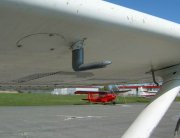Vernor Vinge is an acclaimed science fiction author and futurist. The Long Now Foundation is an organization of technologists, artists, and others dedicated to pondering the challenges facing society on very long time scales, on the order of thousands of years. And “the Singularity” is a concept invented decades ago by Vinge that says, in effect: technological progress is advancing almost unavoidably to a point (called the Singularity) where technology itself will exceed the intelligence and abilities of humans. After the Singularity, continued technological advancement is in the hands of technology that’s literally superhuman. It proceeds at a superhuman pace according to superhuman motives. Just as our laws of physics break down at the event horizon of a black hole, it is in principle impossible for us to make predictions about the future beyond the Singularity, when things will be as incomprehensible to us humans as, in Vinge’s words, “opera is to a flatworm.”
Although Vinge believes that the Singularity is the likeliest non-catastrophic outcome for the future of humanity (and there are many who agree and many who don’t), his talk to The Long Now Foundation addressed alternative, non-Singularity possibilities. What might prevent the Singularity from occurring? War and various catastrophes on a global scale are obvious ones. But there are two interesting non-Singularity possibilities that Vinge did not discuss.
The less interesting and less likely of the two possibilities is that there is some fundamental limit on the complexity of information processing systems, and human brains are already at or near that limit. If these two suppositions are true, then it is not possible for technology to exceed human reasoning or inventing power by a significant amount — though it would still be possible to employ vaster, harder-working armies of reasoning and inventing machines than it would be to recruit similar numbers of people. (Interestingly, Vinge posits just such a fundamental limitation in his science fiction masterpiece, A Fire Upon The Deep — a rousing and thought-provoking adventure, and the only sci-fi story I’ve ever come across that feels truly galactic in scope.)
Here’s the non-Singularity possibility I like better: though machine intelligence may exceed that of humans, human intelligence can keep up, like Dr. Watson arriving at a conclusion or two of his own while following Sherlock Holmes around, or like me surrounding myself with friends whose superior intellect and wit eventually rubbed off on me, at least a little.
Consider that a hundred years ago, it took geniuses at the pinnacle of human intelligence to devise the counterintuitive physical theories of relativity and quantum mechanics that, today, are grasped (in their rudiments) by children in middle school. Consider that the same race of beings that once gazed up at the heavens and made up fairy tales about the constellations has now charted and explained very much of the visible universe, almost all the way back to the beginning of time — and it took only a few dozen centuries.
Perhaps there are realms of thought and invention that require posthuman brainpower to discover. But I’m optimistic that where our future technology leads, we can follow.
 The rate-of-climb indicator, also called the vertical-speed indicator or VSI, is one of six instruments in the standard instrument cluster familiar to airplane pilots. It reports the rate at which the airplane’s altitude is changing, in hundreds of feet per minute. (Interesting fact: in an unpressurized airplane cabin, a comfortable rate of descent is five hundred feet per minute. Much more than that and passengers will begin to feel ear pain from the pressure changes. So a pilot flying 5,000 feet above the elevation of his or her destination should begin descending while still ten minutes away from the airfield.)
The rate-of-climb indicator, also called the vertical-speed indicator or VSI, is one of six instruments in the standard instrument cluster familiar to airplane pilots. It reports the rate at which the airplane’s altitude is changing, in hundreds of feet per minute. (Interesting fact: in an unpressurized airplane cabin, a comfortable rate of descent is five hundred feet per minute. Much more than that and passengers will begin to feel ear pain from the pressure changes. So a pilot flying 5,000 feet above the elevation of his or her destination should begin descending while still ten minutes away from the airfield.) The altimeter, another standard instrument, is much easier to understand. It registers the airplane’s height above sea level by measuring the ambient air pressure. (Interesting fact: the ambient air pressure runs to the altimeter through a tube originating at a tiny hole in the skin of the plane called the “static port.” An airplane in flight affects the pressure of the air all around it; the static port is strategically placed where the effect on the surrounding air pressure is neutral.) Air pressure decreases at a pretty constant rate the higher you go, so if you know the pressure at sea level (a setting that changes from place to place and from hour to hour — pilots periodically get the setting from a radio broadcast and adjust a knob on the altimeter), and you know the air pressure, then you know your altitude. The altimeter is nothing but a funny-looking barometer calibrated in feet above sea level.
The altimeter, another standard instrument, is much easier to understand. It registers the airplane’s height above sea level by measuring the ambient air pressure. (Interesting fact: the ambient air pressure runs to the altimeter through a tube originating at a tiny hole in the skin of the plane called the “static port.” An airplane in flight affects the pressure of the air all around it; the static port is strategically placed where the effect on the surrounding air pressure is neutral.) Air pressure decreases at a pretty constant rate the higher you go, so if you know the pressure at sea level (a setting that changes from place to place and from hour to hour — pilots periodically get the setting from a radio broadcast and adjust a knob on the altimeter), and you know the air pressure, then you know your altitude. The altimeter is nothing but a funny-looking barometer calibrated in feet above sea level. Even the airspeed indicator, which is a bit cleverer, is easy to understand. It uses two sources of air pressure: the “static” air pressure (from the aforementioned static port), and the “ram” air pressure, which is the pressure of the oncoming air as measured by a tube (the “pitot” tube, rhymes with Frito) pointing forward. Via some simple plumbing, the static pressure is subtracted from the ram pressure and the result is shown on the airspeed dial, calibrated in knots or in miles per hour.
Even the airspeed indicator, which is a bit cleverer, is easy to understand. It uses two sources of air pressure: the “static” air pressure (from the aforementioned static port), and the “ram” air pressure, which is the pressure of the oncoming air as measured by a tube (the “pitot” tube, rhymes with Frito) pointing forward. Via some simple plumbing, the static pressure is subtracted from the ram pressure and the result is shown on the airspeed dial, calibrated in knots or in miles per hour. Yesterday I finally got around to resetting the clock on my answering machine at home after
Yesterday I finally got around to resetting the clock on my answering machine at home after  One of Goldstein’s friends-and-clients, in turn, was a photographer named
One of Goldstein’s friends-and-clients, in turn, was a photographer named  As I toiled at the computer on a wide variety of projects — now programming, now data entry, now educating myself further in CP/M and later
As I toiled at the computer on a wide variety of projects — now programming, now data entry, now educating myself further in CP/M and later  He was among the best in the business and lots of big-name clients came through the studio. Very often they purchased excessive amounts of food for the shoot and left it behind after the shoot was done. Many were the times I lugged a dozen steaks, a few hundred slices of American cheese, or a crate of Ronzoni spaghetti home on the subway.
He was among the best in the business and lots of big-name clients came through the studio. Very often they purchased excessive amounts of food for the shoot and left it behind after the shoot was done. Many were the times I lugged a dozen steaks, a few hundred slices of American cheese, or a crate of Ronzoni spaghetti home on the subway.